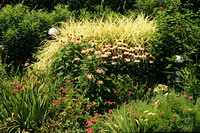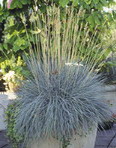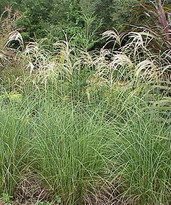Dr. Mack Thetford
 Associate Professor of Environmental Horticulture
Associate Professor of Environmental Horticulture
University of Florida, West Florida Research and Education Center, Milton, Florida
 Ornamental Grasses. Mention this diverse group of plants and you will evoke a variety of mental images for American gardeners. Amber waves of grain, prairie scenes, marsh grasses or the blanket of sea oats along our coasts. Ornamental grasses are a very popular group of plants which have become an integral part of many southern gardens. The availability of a large number of species and cultivars makes this group of plants very versatile with many potential uses in the home landscape. The popularity of this group of plants is, in part, related to the diversity of plants represented. Additional factors attributed to this popularity include ease of culture and tolerance of a broad range of environmental conditions such as drought or boggy, wet areas. The following information should assist the first time gardener as well as the experienced gardener in the selection and use of ornamental grasses.
Ornamental Grasses. Mention this diverse group of plants and you will evoke a variety of mental images for American gardeners. Amber waves of grain, prairie scenes, marsh grasses or the blanket of sea oats along our coasts. Ornamental grasses are a very popular group of plants which have become an integral part of many southern gardens. The availability of a large number of species and cultivars makes this group of plants very versatile with many potential uses in the home landscape. The popularity of this group of plants is, in part, related to the diversity of plants represented. Additional factors attributed to this popularity include ease of culture and tolerance of a broad range of environmental conditions such as drought or boggy, wet areas. The following information should assist the first time gardener as well as the experienced gardener in the selection and use of ornamental grasses.
The first step to proper selection and use of ornamental grasses must begin with an understanding of the broad diversity of plants represented by the term ornamental grass. The term Ornamental Grass is one of those catchall phrases used to describe not only true grasses but other related plants as well. While all of these plants are grasses in the sense that they are monocots, the parallels stop there. It turns out that many of the plants we commonly refer to as grasses are not really grasses but are members of plant families that botanists and gardeners refer to as the grasslikes. The grass family is called Poaceae, although some botanists refer to the grass family by the older family name of Gramineae. The grasslikes generally fall into one of two plant families; the Rushes, which represent the plant family Juncaceae, and the Sedges, which represent the Cyperaceae family. All three plant families contain plants adapted to a wide variety of habitats and planting conditions. Within each of these plant families one may find individual species adapted to wet or dry, sun or shade, hot or cold climates or any combination thereof. Growth habits are equally diverse representing low ground covers to intermediate shrub-like to very tall hedge-like plants.
Using grasses in the landscape can be an overwhelming task for beginning gardeners, there are many species and cultivars to choose from and so many design possibilities. Ornamental grasses are very dynamic and do not maintain a permanent structure in the garden like most of our shrubs and trees. The size, shape, texture and color of grass will change with every season. Deciding how to use ornamental grasses in the landscape becomes a relatively easy process when we consider a few plant characteristics. The first characteristic to consider is if the plant is an annual or perennial. A perennial grass will live for many years while an annual grass will only last one season and will die after flowering or it may be killed when exposed to freezing temperatures. Other characteristics to consider when making your grass selections include growth form, mature size, if the foliage is winter hardy (evergreen) or not (deciduous), foliage color, and time of flowering. While much of this information should be available from catalog descriptions, it is important to understand how these characteristics can be used to your advantage when designing your garden.
Ornamental grasses can be classified into two fairly distinct categories based on their growth form. There are clumpers and spreaders and the spreaders are often called creepers. The clumping grasses increase in size each year by forming new divisions called culms. This results in the plant increasing in width at its base but basically remaining in the same position over time without spreading to other locations in the garden. The spreading grasses differ by increasing in size each year by forming rhizomes or stolons. These grasses may also increase in size by forming culms in addition to the rhizomes or stolons. Rhizomes are below ground stems while stolons are aboveground horizontal stems. These structures allow this type of grass to spread in any direction from the original plant and the spreading or creeping characteristic often results in these grasses being used as ground covers.
The mature size of an ornamental grass is an important aspect to consider when selecting the proper plant for your landscape design. The interesting thing about these plants is that the height, foliage spread, and overall shape may vary by season. Even the tallest of grasses may only be a few inches tall in the spring following an annual pruning. The height will increase dramatically over the spring but if you are using a tall species for screening unwanted views it is important to keep this in mind as you make your selection. Foliage spread and understandably, overall plant form will also vary with the season. An interesting transformation will occur as new foliage is produced in the spring resulting in an upright narrow plant that may become a vase-shaped plant by summer while flowers emerging in the fall may make the plant appear more rounded. Regardless of the mature size or growth form of the grass selected, the ornamental grass gardener should be prepared for a dynamic garden offering a great deal of interest for all seasons.
 Foliage Color and Hardiness are important considerations when selecting ornamental grasses. The foliage of ornamental grasses offers a veritable pallet of colors ranging from greens, grays, blues, and browns to yellows and creams. Foliage patterns are equally diverse with variegation patterns of horizontal or vertical stripes. The interest doesnt stop there. Fall colors can range from yellow to orange to red while winter color can vary from light tan to dark brown. Regardless of the season, ornamental grasses can provide a striking contrast of color, create an accent or focal point, or they can provide very subtle greens and grays to create a backdrop for other plants in the garden.
Foliage Color and Hardiness are important considerations when selecting ornamental grasses. The foliage of ornamental grasses offers a veritable pallet of colors ranging from greens, grays, blues, and browns to yellows and creams. Foliage patterns are equally diverse with variegation patterns of horizontal or vertical stripes. The interest doesnt stop there. Fall colors can range from yellow to orange to red while winter color can vary from light tan to dark brown. Regardless of the season, ornamental grasses can provide a striking contrast of color, create an accent or focal point, or they can provide very subtle greens and grays to create a backdrop for other plants in the garden.
 Fall and winter color will vary greatly based on your gardening location. The weather patterns in your location will influence foliage hardiness. Grasses for which the foliage is winter hardy are often referred to as evergreen while grasses for which the foliage is not winter hardy are often referred to as deciduous. Many of the deciduous grasses will have the potential to add fall and winter color to your garden while the evergreen grasses can serve as the foundation for creating bold or dramatic color contrasts.
Fall and winter color will vary greatly based on your gardening location. The weather patterns in your location will influence foliage hardiness. Grasses for which the foliage is winter hardy are often referred to as evergreen while grasses for which the foliage is not winter hardy are often referred to as deciduous. Many of the deciduous grasses will have the potential to add fall and winter color to your garden while the evergreen grasses can serve as the foundation for creating bold or dramatic color contrasts.
The Time of growth and flowering may be an important consideration in the selection of ornamental grasses. Many cool season grasses flower in the spring. Cool season grasses grow primarily in the cooler months and are dormant through the hot or dry months. Warm season grasses may flower throughout the summer or in the fall. Warm season grasses grow primarily in the warm months and are dormant through the cooler months. Flowering is the primary selection criterion for many gardeners since many grasses will retain their flower heads for many weeks or months after the seeds are formed. For this reason, pruning grasses immediately after flowering is generally not recommended. Allowing the flower heads to remain through the winter months not only extends the flowering period but retains the aesthetic value of the grasses until spring.
Pruning of ornamental grasses should be scheduled for early spring just prior to new growth. Evergreen grasses may only require the removal of old flower stalks while deciduous grasses may require complete removal of the dead foliage and flower stalks from the previous season. Grasses usually do not require pruning during the growing season except for those creeping grasses getting too close to the lawn. Much aggravation can be avoided by separating your grasses from the lawn with a minimum of 1 to 2 feet of mulched buffer zone. This buffer will allow easy removal of lawn or ornamental grasses before they become intertwined.
Landscape establishment of ornamental grasses will require preparation of the planting site. You should follow the established recommendations for your location to ensure the pH and fertility are appropriate. Your local garden center or County Extension Agent should be a great source for information and soil test kits. Remember, ornamental grasses, just like other plants, should not be planted any deeper than the top of the original rootball. Just like strawberries, the crown (the root and shoot junction) of grasses should be located at the soil line. Watering during establishment is a must! Regardless of how drought tolerant a grass species may be we should always water the original rootball of the transplant and the surrounding soil until the plant has roots established in the native soil of your garden. If you must irrigate, consider a drip irrigation system rather than an overhead system. The overhead irrigation will be harsh on the delicate flowers of the grasses and may diminish the impact of the flowers or shorten the flowering period.
Since ornamental grasses are a relatively new group of plants for our southern gardens, many local garden centers may not have very large selections. Don't be bashful if you don't find the grass you are looking for, ask your local garden center to locate and stock these plants. For those selections you do find locally, be prepared to see plants that may not be as attractive as those pictured in catalogs and magazines. Many grasses, especially those that quickly reach heights above 3 to 4 feet, may require pruning during the production cycle to prevent the wind from toppling the plants. Tall plants are also difficult to ship from the grower/producer to the garden center so this may make some of the larger, taller selections a bit more difficult to locate. Remember, the way a grass looks in a pot at the garden center may not reflect the ultimate appearance or size it will have once established in the garden.
Mention of products, services or companies does not imply an endorsement by the University of Florida. This article and the "Gallery" which follow are together published as the Florida Agricultural Experiment Station Journal Series number - T0480
Dr. Mack Thetford is associate professor of environmental horticulture, University of Florida, West Florida Research and Education Center, Milton, Florida. He can be reached at his email [thetford@ufl.edu] for further information.